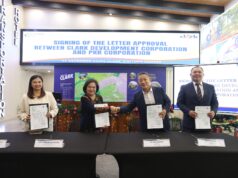PGKM Chair Ruperto Cruz described here yesterday the multi-billion project as a “second rate duplicate” of SM City Clark.
“It looks like a template of SM,” said Cruz noting that the project would also involve retail, business process outsourcing (BPO) and even residential units.
“They realized the success of SM and now they want to duplicate it by putting it at the main gate of the freeport,” he said.
This is a clear redundancy of a project that can be put up somewhere else or at the so called Clark Green City and not diametrically opposite SM if the proponents are serious in putting it in Clark, he reasoned.
If the Capilion project pushes through, the main road leading to Clark will be choked with traffic, Cruz said pointing out that M.A. Roxas Avenue, which is the main thoroughfare of Clark, is already choked with traffic during rush hour and special events like the hot air balloon fiesta.
“It will greatly contribute to the traffic gridlock in Clark leading to the airport just like the horrendous traffic on roads going to the Ninoy Aquino International Airport (NAIA),” he added.
Mayor Ed Pamintuan said he was initially informed by Clark Development Corp. (CDC) President-CEO Arthur Tugade that the Capilion project would double the city’s income it derives from SM.
But what about the social cost? asked Cruz who said that this could also be part of the sabotage against the full and immediate development of the Clark International Airport (CIA).
The main entrance to Clark should be free of any structure to accommodate future road expansions, he said.
M.A. Roxas should be expanded from its present four to six lanes and Don Juico Avenue, which runs parallel to the main Clark road, should be widened into a four lane highway to make the CIA easily and more accessible, said Cruz.
Councilor Max Sangil, a columnist of a local daily, wrote that “the Capilion area was precisely freed by the various comprehensive land use plans as a buffer zone.”
It was Sangil that sponsored the city council Resolution 7184, S-2015 expressing “vehement opposition” to the project.
Sangil also agreed with PGKM’s observation that the main road to Clark and the parallel road beside it should be free of any structures for future expansion and widening.
City jurisdiction But more importantly, Sangil pointed out that biggest argument against the Capilion project is the fact that it is already beyond its jurisdiction.
The CDC cannot unilaterally sign a lease agreement for the area without the approval of the city government through a public consultation, he said.
Sangil cited House Bill No. 5064 and the Senate Bill No. 2260 which were filed in congress that eventually became Republic Act 9400 which is an act amending Republic Act 7227.
Sangil said the amendment exempted 22 hectares from the Clark Freeport Zone which includes the Capilion area.
“For clarity, it is specifically expressed under section 15 of R.A. 9400: The Clark Air Base proper with an area of not more than 4,400 hectares, with the exception of 22 hectares commercial area situated near the main gate and the Bayanihan Park consisting of seven and half hectares located outside the main gate of the Clark special economic zone, is hereby declared freeport zone,” wrote Sangil.
“It is clear as the morning sun on a summer day that 29.5 hectares were exempted as part of the Clark Freeport, hence they are now part of the territorial jurisdiction of Angeles City,” he argued.
Barangay Captain Rey Gueco of Malabanias, which covers the Clark main gate, supported the project based only on his personal assessment because he never consulted his constituents about the pros and cons of the project in a public consultation, the PGKM said.
Meanwhile, the CDC refused to give a copy of the lease agreement contract it signed with Capilion citing a “confidentiality clause” under the contract.
But Cruz expressed fears that this could be a case of “corporate layering” to hide the true identity of the investor under the Capilion Corp. Pte. Ltd. that is why they shun scrutiny of the contract.
On Thursday, Tugade was at the launching of the Department of Science and Technology (DOST) Hybrid Road Train in Clark but was hard-pressed in commenting on the issue.




